Functional CDKN2A assay identifies frequent deleterious alleles misclassified as variants of uncertain significance
- PMID: 35001868
- PMCID: PMC8824478
- DOI: 10.7554/eLife.71137
Functional CDKN2A assay identifies frequent deleterious alleles misclassified as variants of uncertain significance
Abstract
Pathogenic germline CDKN2A variants are associated with an increased risk of pancreatic ductal adenocarcinoma (PDAC). CDKN2A variants of uncertain significance (VUSs) are reported in up to 4.3% of patients with PDAC and result in significant uncertainty for patients and their family members as an unknown fraction are functionally deleterious, and therefore, likely pathogenic. Functional characterization of CDKN2A VUSs is needed to reclassify variants and inform clinical management. Twenty-nine germline CDKN2A VUSs previously reported in patients with PDAC or in ClinVar were evaluated using a validated in vitro cell proliferation assay. Twelve of the 29 CDKN2A VUSs were functionally deleterious (11 VUSs) or potentially functionally deleterious (1 VUS) and were reclassified as likely pathogenic variants. Thus, over 40% of CDKN2A VUSs identified in patients with PDAC are functionally deleterious and likely pathogenic. When incorporating VUSs found to be functionally deleterious, and reclassified as likely pathogenic, the prevalence of pathogenic/likely pathogenic CDKN2A in patients with PDAC reported in the published literature is increased to up to 4.1% of patients, depending on family history. Therefore, CDKN2A VUSs may play a significant, unappreciated role in risk of pancreatic cancer. These findings have significant implications for the counselling and care of patients and their relatives.
Keywords: CDKN2A; cancer; cancer biology; familial cancer; genetics; genomics; human; pancreas; pancreatic ductal adenocarcinoma; variant of uncertain significance.
© 2022, Kimura et al.
Conflict of interest statement
HK, NN, LW, JE, MG, AK, NR No competing interests declared, RH RHH has the right to receive royalty payments from Thrive Earlier Diagnosis for the GNAS in pancreatic cysts invention in a relationship overseen by Johns Hopkins University
Figures
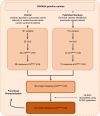
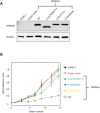
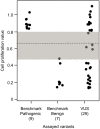

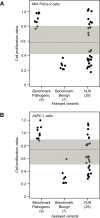
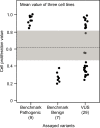

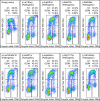
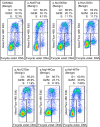



Similar articles
-
The Role of Inherited Pathogenic CDKN2A Variants in Susceptibility to Pancreatic Cancer.Pancreas. 2021 Sep 1;50(8):1123-1130. doi: 10.1097/MPA.0000000000001888. Pancreas. 2021. PMID: 34714275 Free PMC article. Review.
-
Gene-Level Associations in Patients With and Without Pathogenic Germline Variants in CDKN2A and Pancreatic Cancer.JCO Precis Oncol. 2022 Nov;6:e2200145. doi: 10.1200/PO.22.00145. JCO Precis Oncol. 2022. PMID: 36409970 Free PMC article.
-
A comprehensive analysis of candidate genes in familial pancreatic cancer families reveals a high frequency of potentially pathogenic germline variants.EBioMedicine. 2020 Mar;53:102675. doi: 10.1016/j.ebiom.2020.102675. Epub 2020 Feb 27. EBioMedicine. 2020. PMID: 32113160 Free PMC article.
-
Pancreatic cancer surveillance: Risk stratification of individuals with a germline CDKN2A pathogenic variant.United European Gastroenterol J. 2024 Dec;12(10):1399-1403. doi: 10.1002/ueg2.12662. Epub 2024 Nov 7. United European Gastroenterol J. 2024. PMID: 39508364 Free PMC article.
-
A systematic review of the prevalence of germline pathogenic variants in patients with pancreatic cancer.J Gastroenterol. 2021 Aug;56(8):713-721. doi: 10.1007/s00535-021-01806-y. Epub 2021 Jul 13. J Gastroenterol. 2021. PMID: 34255164 Free PMC article.
Cited by
-
Genetic evaluation of pediatric pituitary adenomas and USP8-related genotype-phenotype correlations in Cushing's disease.Pituitary. 2025 Aug 14;28(5):92. doi: 10.1007/s11102-025-01557-6. Pituitary. 2025. PMID: 40813536 Free PMC article.
-
Population screening shows risk of inherited cancer and familial hypercholesterolemia in Oregon.Am J Hum Genet. 2023 Aug 3;110(8):1249-1265. doi: 10.1016/j.ajhg.2023.06.014. Epub 2023 Jul 27. Am J Hum Genet. 2023. PMID: 37506692 Free PMC article.
-
Significance of TP53, CDKN2A, SMAD4 and KRAS in Pancreatic Cancer.Curr Issues Mol Biol. 2024 Mar 23;46(4):2827-2844. doi: 10.3390/cimb46040177. Curr Issues Mol Biol. 2024. PMID: 38666907 Free PMC article. Review.
-
Predictors of germline status for hereditary melanoma: 5 years of multi-gene panel testing within the Italian Melanoma Intergroup.ESMO Open. 2022 Aug;7(4):100525. doi: 10.1016/j.esmoop.2022.100525. Epub 2022 Jun 28. ESMO Open. 2022. PMID: 35777164 Free PMC article.
-
Functional characterization of all CDKN2A missense variants and comparison to in silico models of pathogenicity.bioRxiv [Preprint]. 2025 Feb 11:2023.12.28.573507. doi: 10.1101/2023.12.28.573507. bioRxiv. 2025. Update in: Elife. 2025 Apr 16;13:RP95347. doi: 10.7554/eLife.95347. PMID: 38234851 Free PMC article. Updated. Preprint.
References
-
- Bouvet D, Bodo S, Munier A, Guillerm E, Bertrand R, Colas C, Duval A, Coulet F, Muleris M. Methylation Tolerance-Based Functional Assay to Assess Variants of Unknown Significance in the MLH1 and MSH2 Genes and Identify Patients With Lynch Syndrome. Gastroenterology. 2019;157:421–431. doi: 10.1053/j.gastro.2019.03.071. - DOI - PubMed
-
- Brand R, Borazanci E, Speare V, Dudley B, Karloski E, Peters MLB, Stobie L, Bahary N, Zeh H, Zureikat A, Hogg M, Lee K, Tsung A, Rhee J, Ohr J, Sun W, Lee J, Moser AJ, DeLeonardis K, Krejdovsky J, Dalton E, LaDuca H, Dolinsky J, Colvin A, Lim C, Black MH, Tung N. Prospective study of germline genetic testing in incident cases of pancreatic adenocarcinoma. Cancer. 2018;124:3520–3527. doi: 10.1002/cncr.31628. - DOI - PubMed
-
- Canto MI, Harinck F, Hruban RH, Offerhaus GJ, Poley JW, Kamel I, Nio Y, Schulick RS, Bassi C, Kluijt I, Levy MJ, Chak A, Fockens P, Goggins M, Bruno M, International Cancer of Pancreas Screening CAPS Consortium International Cancer of the Pancreas Screening (CAPS) Consortium summit on the management of patients with increased risk for familial pancreatic cancer. Gut. 2013;62:339–347. doi: 10.1136/gutjnl-2012-303108. - DOI - PMC - PubMed
-
- Canto M.I, Almario JA, Schulick RD, Yeo CJ, Klein A, Blackford A, Shin EJ, Sanyal A, Yenokyan G, Lennon AM, Kamel IR, Fishman EK, Wolfgang C, Weiss M, Hruban RH, Goggins M. Risk of Neoplastic Progression in Individuals at High Risk for Pancreatic Cancer Undergoing Long-term Surveillance. Gastroenterology. 2018;155:740–751. doi: 10.1053/j.gastro.2018.05.035. - DOI - PMC - PubMed
Publication types
MeSH terms
Substances
Grants and funding
LinkOut - more resources
Full Text Sources
Other Literature Sources
Medical
Research Materials
Miscellaneous

